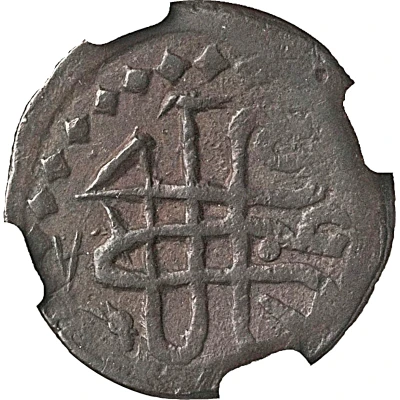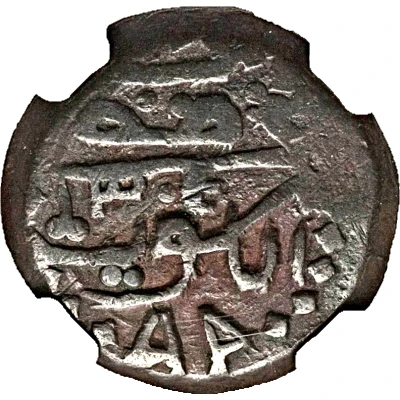


© Heritage Auctions
1 Baiza - Abdullah II date in center
1304 (1886) year| Copper | 6.18 g | 22.5 mm |
| Issuer | Kuwait |
|---|---|
| Emir | Abdullah II Al-Sabah (1866-1892) |
| Type | Standard circulation coin |
| Year | 1304 (1886) |
| Calendar | Islamic (Hijri) |
| Value | 1 Baiza (1⁄64) |
| Currency | Baiza (1886-1887) |
| Composition | Copper |
| Weight | 6.18 g |
| Diameter | 22.5 mm |
| Shape | Round (irregular) |
| Technique | Hammered |
| Demonetized | Yes |
| Updated | 2024-10-06 |
| Numista | N#95988 |
|---|---|
| Rarity index | 90% |
Reverse
Mint and date, possibly reads "Struck in Kuwait 1304" in Arabic with something like "AA" at the bottom
Note: date in the center of the coin, unlike KM#A2
Lettering:
ضرب
في
١٣٠٤
الكويت
AA
Translation:
Struck
in
1304
Kuwait
AA
Comment
In 1886–1887, under Sheikh Abdullah II, Kuwait began minting coins in copper due to the lack of Indian rupees circulating in the local economy.The primitive, crude, hammered coins were locally produced. According to Kuwaiti Islamic coin specialist M. Al-Hoseini, the person overseeing the minting operation was a senior member of the prominent Bodi tribe. Very few coins were produced, with up to 4 possible types with notable distinctions in the text, design, and even planchet thickness. The coins circulated for several weeks but were short lived.
Source: https://arabiancoins.wordpress.com/tag/kuwait/
Sheikh Abdullah II Sabah II Al-Jabir I Al-Sabah (1814–1892) was a lead cavalry commander in the Military of Kuwait, the fifth ruler of Kuwait and oldest son of the fourth ruler of Kuwait. He spent much of his rule dealing with natural disasters, maintaining stability as well as building stronger ties with the Ottoman Empire which supplied the most vital resource in Kuwait, drinking water. Furthermore, the first coins minted by Kuwait began during his reign.
Another example:
© Image courtesy of A. H. Baldwin & Sons Ltd
Interesting fact
The 1 Baiza coin from Kuwait, featuring Abdullah II and dated 1304 (1886), was made of copper and weighed 6.18 grams. That's relatively lightweight compared to other coins of similar value and size, which were often made of heavier metals like silver or gold. This choice of material may have been influenced by the economic and cultural context of Kuwait at the time, as copper was a more affordable and accessible material for coinage.